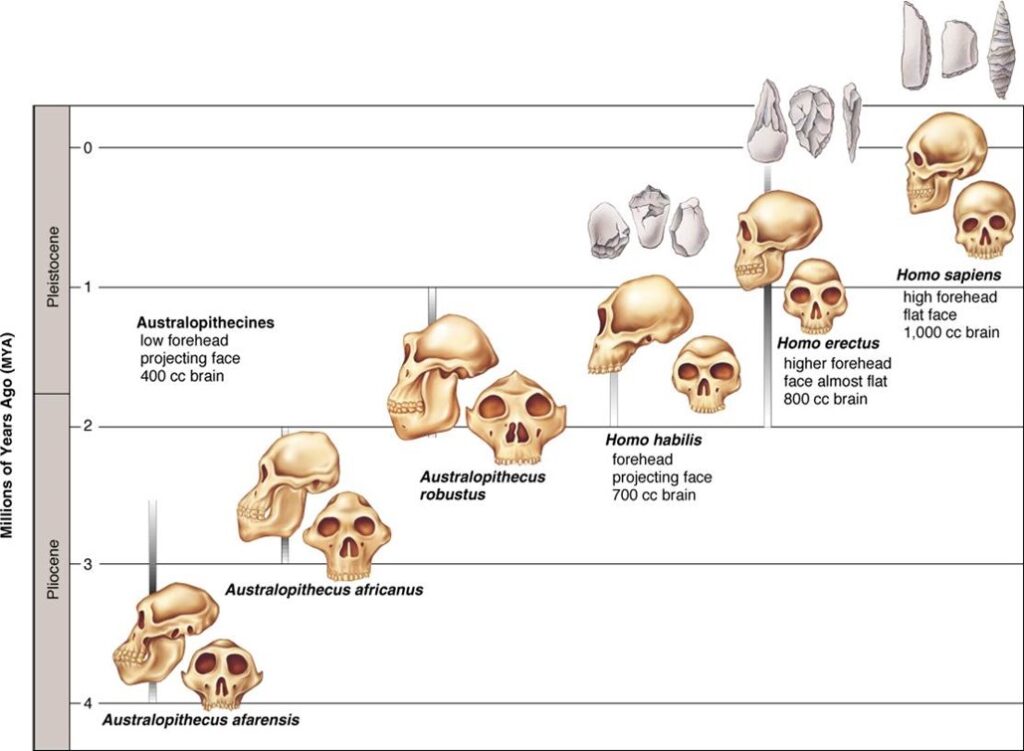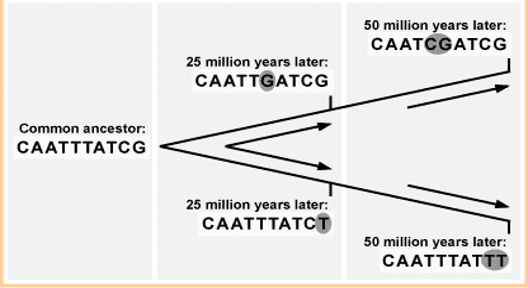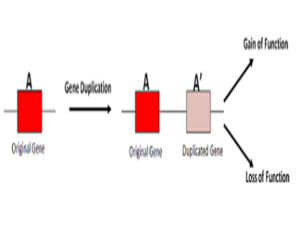TRENDS IN EVOLUTION
Introduction
An evolutionary trend can be either directional change within a single lineage or parallel change across lineages, in other words, several lineages undergoing the same sort of change. However, not just any change counts as a trend. After all, if the weather gets warmer one day, you wouldn’t call it a warming trend; warming would have to go on for some length of time before you’d call it a trend. Biologists think about evolutionary trends in the same way — there has to be something about the change that suggests that it’s not just a random fluctuation before it counts as a “trend.”

For example, titanotheres (a cool, extinct clade related to modern horses and rhinos) exhibit an evolutionary trend. Titanotheres had bony protuberances extending from their noses. The sequence of fossil skulls from these animals shows that evolutionary changes in the size of these “horns” were not random; instead, changes were biased in the direction of increasing horn size. And in fact, several different titanothere lineages experienced the same sort of change in horn size.

Molecular Evolution
Molecular evolution is the process of change in the sequence composition of cellular molecules such as DNA, RNA, and proteins across generations.

Gene Evolution
A gene is the basic physical and functional unit of heredity.
Genome evolution is the process by which a genome changes in structure (sequence) or size over time. The study of genome evolution involves multiple fields such as structural analysis of the genome, the study of genomic parasites, gene and ancient genome duplications, polyploidy, and comparative genomics. Genome evolution is a constantly changing and evolving field due to the steadily growing number of sequenced genomes, both prokaryotic and eukaryotic, available to the scientific community and the public at large.
Types Gene Evolution
- MUTATION
- HORIZONTAL GENE TRANSFER
- SEXUAL REPRODUCTION
Mutation
Mutation is a change in DNA, the hereditary material of life. An organism’s DNA affects how it looks, how it behaves, and its physiology all aspects of its life. So a change in an organism’s DNA can cause changes in all aspects of its life.
Mutations are random. Mutations can be beneficial, neutral, or harmful for the organism, but mutations do not “try” to supply what the organism “needs.” In this respect, mutations are random whether a particular mutation happens or not is unrelated to how useful that mutation would be.
Not all mutations matter to evolution. Since all cells in our body contain DNA, there are lots of places for mutations to occur; however, not all mutations matter for evolution. Somatic mutations occur in non-reproductive cells and won’t be passed onto offspring
Horizontal Gene Transfer
- Process in which an organism incorporates genetic material from another organism without being its offspring Common in bacteria and Achaea, rare in eukaryotic cells Genetic information transferred via conjugation, transduction, and translation.
Transformation, the genetic alteration of a cell resulting from the introduction, uptake and expression of foreign genetic material (DNA or RNA). This process is relatively common in bacteria, but less so in eukaryotes. Transformation is often used in laboratories to insert novel genes into bacteria for experiments or for industrial or medical applications. See also molecular biology and biotechnology.
Transduction, the process in which bacterial DNA is moved from one bacterium to another by a virus (a bacteriophage, or phage).
Bacterial conjugation, a process that involves the transfer of DNA via a plasmid from a donor cell to a recombinant recipient cell during cell-to-cell contact.
Gene transfer agents, virus-like elements encoded by the host that are found in the alphaproteobacteria order Rhodobacterales.
- The movement of genetic material between two organisms. Once incorporated it is then ‘vertically’ inherited.
- Also called Lateral Gene Transfer.
- HGT and LGT for short.

Sexual Reproduction
- Sexual reproduction is a form of reproduction where two different type of specialized reproductive cell called gamete fuse together. It has been described powerful evolutionary that does not exist in asexual population.
Evolution Of Gene Families
- A gene family is a group of genes that share important characteristics
- In many cases genes in a family share a similar sequence of DNA building blocks.
- These gene provide instruction for making product that have similar structure and function.
- All the genes which are originated from same ancestor .

Formation Of Gene Family
- Gene duplication
- Gene conversion
Gene duplication
Gene duplication (or chromosomal duplication or gene amplification) is a major mechanism through which new genetic material is generated during molecular evolution. It can be defined as any duplication of a region of DNA that contains a gene.
What is the role of gene duplication in evolution?
- Gene duplicationis an important mechanism for acquiring new genes and creating genetic novelty in organisms. Gene duplication can provide new genetic material for mutation, drift and selection to act upon, the result of which is specialized or new gene functions.

Gene conversion
- Gene conversion is the process by which one DNAsequence replaces a homologous sequence such that the sequences become identical after the conversion event. Gene conversion can be either allelic, meaning that one allele of the same gene replaces another allele, or ectopic, meaning that one paralogous DNA sequence converts another.
ASSESMENT OF MOLECULAR VARIATION
- Molecular markers have ability to detect genetic variation and provide a reliable method to ensure the integrity of cultivars genetic constitution.
- Heritable variation within and between population of organism.
- Encoded in the sequence of four base pair that makes up DNA.
Evolutionary Process
- NATURAL SELECTION :- The process whereby organisms better adapted to their environment tend to survive and produce more offspring. The theory of its action was first fully expounded by Charles Darwin, and it is now regarded as be the main process that brings about evolution.
- GENE FLOW :- In population genetics, gene flow (also known as gene migration or allele flow) is the transfer of genetic variation from one population to another. If the rate of gene flow is high enough, then two populations are considered to have equivalent genetic diversity and therefore effectively be a single population.
- GENETIC DRIFT :- Variation in the relative frequency of different genotypes in a small population, owing to the chance disappearance of particular genes as individuals die or do not reproduce.
Conclusion
- Evolution is change in the heritable characteristics of biological population over successive generation.
- Molecular evolution is change in the sequence of molecule of cell.
- Evolutionary genetics is study where how change in genes leads to change.
- Molecular markers have ability to detect genetic variation.
Discover more from ZOOLOGYTALKS
Subscribe to get the latest posts sent to your email.

